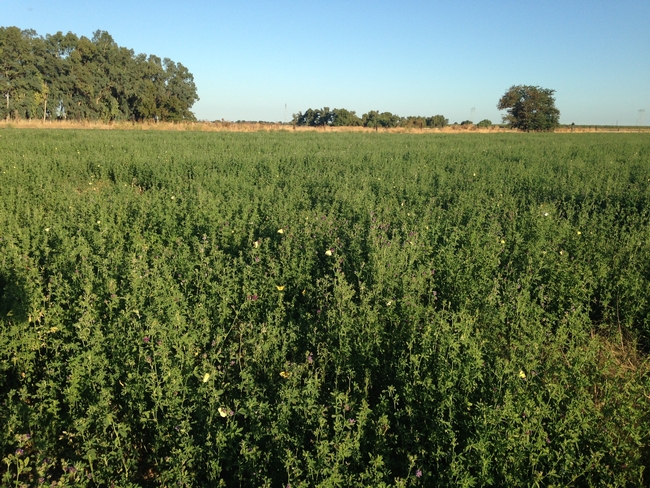By Rachael Long
OK - those millions of pretty yellow and white butterflies that have fluttered over fields and ditches and smeared across your windshields - what are they?
Alfalfa fields appear more yellow and white than green with outbreaks of alfalfa caterpillar (Colias eurytheme) butterflies in some fields this year in the Sacramento Valley. There have been massive populations observed throughout the Sacramento and San Joaquin Valleys.

Although these butterflies are pretty, in this case looks are deceiving. High numbers of butterflies are a warning sign, as they can be serious pests of alfalfa. The larvae, green caterpillars with a white strip along their sides, consume entire leaves and can strip a plant, causing significant reductions in yield and quality if numbers are high enough. Missing leaves or bare stems can be observed - this is a problem since the leaves are where most of the high quality nutritional value of alfalfa resides.
A number of alfalfa growers have been forced to apply pesticides to control this pest.

Alfalfa caterpillars - Yolo County, California
Alfalfa caterpillars often exist in a complex with other worm-like pests. Other summer worm pests such as Armyworms (western yellowstriped and beet) in contrast skeletonize leaves, leaving veins largely intact. Heavy feeding on the tips of plants can cause flagging as they turn white (also called whitecaps). This is not to be confused with stem nematode that can also cause white flagging, but the foliage will not be tattered.
The larvae of the western yellowstriped caterpillars are usually black, with two prominent stripes and many narrow bright ones on each side. Beet armyworm is olive green to almost black with a yellow stripe on each side of the body.
For identification of the different species in the summer worm complex in alfalfa see the UC IPM website: http://ipm.ucanr.edu/PMG/selectnewpest.alfalfa-hay.html
Alfalfa caterpillars and armyworms are summer pests with multiple generations per year. Their populations are cyclical, occurring in large numbers every few years. Factors contributing to economic populations are slow and uneven growth of the crop, lack of beneficial parasitoid wasps that feed on these pests, and hot, dry weather.
RECOMMENDATIONS FOR CONTROL: Start sweeping for armyworms and alfalfa caterpillars during early summer and continue through early fall. Take weekly sweep net samples to determine counts of these pests along with their parasitoid wasp natural enemies. The threshold is 10 or more combined nonparasitized alfalfa caterpillars and armyworms per sweep. For more information on how to identify the wasp parasitoids, see the UC IPM YouTube video: http://ipm.ucanr.edu/PMG/r1900711.html
If threshold numbers are reached and the field is not close to cutting, several products are registered for use in alfalfa including Coragen, Intrepid, and Bacillus thuringiensis (Bt-various products). Unfortunately for Belt, the U. S. EPA's Environmental Appeals Board has sided with an earlier EPA decision to cancel the registration of Belt (flubendiamide) insecticide, but allowing the sales and use of existing stocks.
Source:ucanr.edu